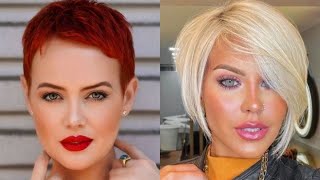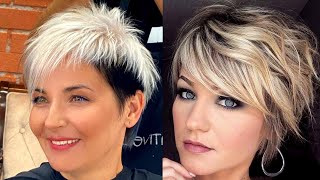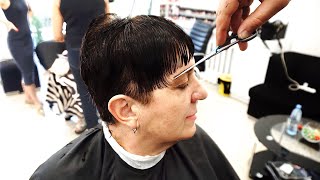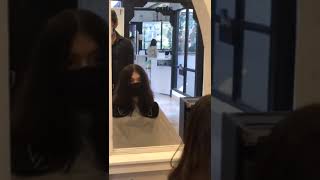How To Cut Hair: Long Layered Haircut Tutorial - Mig Training
- Posted on 16 January, 2020
- Long Hair
- By Anonymous
Welcome to the MIG Collection
"The Steph" is our first video from the collection which contains 8 haircuts, that start as fundamentals for hairdressers.
Ever wanted to know how to cut a one length hair cut and have long layers which are soft and not to visible.
This video is a quick tutorial on how to create a long length haircut.
Filmed in our beautiful training studio as a how to for the Hairdressing apprentices and students we train. Hope you find this easy to follow.
Stay tuned new how to videos coming monthly both colour and more advanced cuts coming soon.
Please SUBSCRIBE and LIKE our videos
Don't forget to follow us on our social platforms:
Instagram: https://www.instagram.com/mig_training...
Facebook: http://facebook.com/migtraining
or check our latest news at:
https://www.migtraining.com.au/
www.migtraining.com.au/the-mig-journal...
Welcome to MIG today I'll be showing you how to perform a long combination. Haircut will be using solid and increased layering structures and working with some face shaping and texturizing techniques. This is our first haircut from our collection, which will be a series of eight haircuts. It will include six ladies and two men's. This will help you with completing a total look from start to finish. My model has very long hair and loves her length. We discussed longer layers that were not too obvious and more shaping around the front so that she has something to play with when she wears her hair up to start my salad, I'm sectioning with my comb. I use the wide part of my comb so that I get an even line and don't create too much tension. I'Ve created a center section from the middle of the forehead down to the night. My client has a very long hair, so I spend a bit of time combing and making sure that I get everything nice and clean. Make sure, when cutting solid, that you keep the links that you're not cutting out of the way and clip them but make sure the hair is not in your clients face when working with really long hair. I'Ve got my model sitting on a stool today, you could perfectly get them to stand up if the cat chair was going to get in the way when cutting solid. I don't cut straight on my fingers. As my fingers are not straight. I cut just a little bit below it, but make sure I have good tension with my fingers for the sole that I'm creating today. I'M just blunt cutting it as I don't want to create a PC wispy ends. If your client, however, wanted this, you could do some point cutting techniques. I continue horizontal sections and working up the head and making sure to comb and make sure that everything is nice, and even so I create a balanced look. I direct all the head to the back as well, so that I create a very straight line. If you were to guide the hair over the shoulders to cut your solid you could round or disturb your baseline. I try not to cut past my second knuckle when I'm cutting my solid so that I don't chop into my palm always double-check your solid as you're cutting. Don'T just assume that your first cuts perfect. I always check my guide and make sure that I'm working with the best possible outcome. I use my comb to section for my solids. Some people will want to use clips. This is just my preference feel free to do whatever feels comfortable and natural for you when cutting salat, make sure you're always standing right behind your section so that you can see what you're doing for the purpose of this video. I am a little bit further away from where I would normally be. I use my comb to make sure that it's very straight. This is the best way that I can make sure that I create strong lines. I'Ve used a cutting lotion as well, so the hair will stay nice and moist for me and I continually spray it down when working with such precision work, you need to make sure you're working from wet to dry. Don'T ever try and cut a solid when it's really dry, it will move and bounce and do all sorts of things going over your work and making sure it's perfect. Do that before you start to move on to your layers for the layer part of this haircut, I've sectioned the front out. I'Ve made a radial section from the top of the head and ear to ear, I'm going to work with the back first and then I will connect the sites in later. The first thing I do when I'm cutting any kind of layout, especially in long hair, is I want to check for where my shortest layer is going to be, and I'm creating a center section. This section will be about the width of your comb. If you're dealing with finer hair, you could take it a little bit larger and, if you're dealing with thicker hair types, if you would have to take it a bit smaller. This is where I measured to see where my shortest lair will be I'm angling, the hair out from the head at 90 degrees to follow the natural curve of the head. This will create more of a rounder line and give me a little bit more definition within my layers. My models, hair is very long, so I'm directing the baseline up to meet that layout so that I don't don't chop into my solid length when you're creating your guide for your layers. You'Ll want to check this a number of times before moving on. If you don't get your guide right, your whole haircut will be out, I'm dividing my guide in half and I'm just going to work with 1/4. I sectioned everything, nice and cleanly and out of the way this looks professional and it helps you follow all your guidelines. I'M working with a PI section: it has a triangular shape. It will be a little bit thinner at the top and a bit thicker at the bottom. I'M now just combing the hair up and checking for my guide and got double combing. Before I cut I'm going to do this technique through the whole pie section, you can see here where I'm lifting up my baseline to make my lace. So I don't cut into my length once again I'm just dividing my guide and then grabbing a new piece of hair in my pie section. This is what we call a mobile guideline. I make sure when I'm combing, that I'm using the wider part of my comb and not the fine part, I don't want to create too much tension as this will make it unbalanced, make sure when you're not cutting like you parmi scissors. This was meaning by removing your thumb from your scissors so that your blades aren't open. I always stand behind my guide. Don'T ever stand in front of your guide, you will not see what you're able to do once I've completed one side. I then come back to the center and divide everything in half and then section the last quarter out and section it away. I'M doing the same technique on this side, as I did on the other side and working with my PI sections and making sure that I'm angling the hair out of exactly the same angle. So I have balance and accuracy. I dropped my arm down to cut my guide if you feel comfortable or more of a beginner. Sometimes it's a good idea to keep your arms up, while you're cutting onto your guide again just working with mobile guidelines and pie shapes through the back. This will give you the best shape for your layering system, and it also follows the shape of the head make sure when you're combing that you're coming from the roots to the ants a couple of times before cutting this is very important. And this will make sure that your lives are perfect, make sure your client's head is in the upright position at all times. It shows to move her head or face down too much. Your layer system would be out always use a mirror to make sure that everything is happening, as it should be. Now that I finished the back lays I'm now creating a stationary guideline. This will be the guideline used to direct all the front back to this. The first thing I do is I make sure that I'm sectioning behind the ear, as this is where the corners can be missed. If you don't grab them, I want to make sure the sections are mirror images of each other when doing this. So the middle of the head here this is all being cut, and this doesn't get cut anymore for sections that I've just created that these are my stationary guidelines. A stationary guideline means where everything is directed to and not moved around. I'M then just working with vertical sections and I'm directing the hair back to this stationary guideline. I always check to say that I can see my guide before I start. Cutting due to my models have been a little bit finer and already having layers, and I was able to just do the front section in two. If you were dealing with thicker hair, you might need to do this in three or four sessions. Typically, the front when you shift it back, there's not an awful lot to cut off, always stand behind your guide as well. Don'T stand in front as you might be too close to your client and you can't see what you're doing I'm repeating the same thing. On the opposite side, I have a good look and make sure everything is sitting nice and now I'm moving on to my blow-dry. I'M going to blow dry the hair, nice and smooth just so I can see there's any heavyweight lines. I'M also going to do some texturizing techniques which will start to blend my layers, I'm using a boar bristle brush, but I'm not connecting my hairdryer to my brush. So I don't burn the hair, I'm just starting my blow-dry at the front. This is just my preference. You can start your blow dryer back wherever you feel comfortable. I'Ve used a little bit of heat protector that I haven't used a lot of product as my models. Hair is absolutely beautiful and in the best condition, I'm trying not to create any volume so that I can make sure that I can check my line and then it's nice and straight. If you were to create volume and movement, it's very hard to make sure that your solid line is perfect. Sometimes it's best to blow-dry it smooth check and then put a volume or curl in it using a tongue or an iron. I'M going to be working with some face shaping so I'm making sure I'm blow-drying the front perfectly and even a little bit forward so that I get rid of any kinks in the hairline. I roughly just make sure I go through with my head right after I finished blow-drying, to remove any excess of moisture. The first thing I do after I've cut anybody's hat using solid. I will get into just tilt the head slightly forward and I'll have a look to save as any graduation present, and I always check my line. I do this kind of freehand and disuse doing my visual aid when dealing with any face shaping. I always like to section the hair from behind the ear away. I don't want to incorporate this into my face, shaping. I believe this is how you can cut off of your corners. You can create strong triangle peaks at the back. You can also create Molony shapes. I'M just free handing this and just working on a diagonal. These are already in the how president Li I'm just removing any wispy areas, I'm quite conservative when I'm doing any face shaping on very long hair. I don't want to make it too short and too obvious. I just want it to be natural and blending once I'm happy with my face shaping. I then will section everything out and I have a look at my corners. I do the exact same thing on the other side, because we wear our hair a little bit off-center. There'S not an awful lot of hair on this side. I just like to make sure that I've got balance if she was to wear it out. A lot of this is just personalizing and just visually. Looking at the haircut, every hairdresser will put their own spin on it. I check my corners to make sure they're nice and blunt as well. I do bring all the hair back over the front and just make sure that I'm balanced and that I have an even blend on both sides. The last part of the haircut, I'm just visually, having a look at where my lights are sitting, I'm going to do some deep point, cutting, which is where you angle, your scissors directly into the hair and a fluid motion. This is the softest texturizing technique. It'Ll just help me blend and it'll make the haircut grow out nicely, I'm following the same sectioning pattern as to how I created the layers so that I don't create any unwanted, shaping or anything random in the hair. I make sure that I pivot my rest and come straight in so it's in its most natural form. I shift the front back to make sure that I point cut slightly as well. I don't do a lot of this in long hair, as I believe that blunt long hair cuts a little beautiful and grow out nicely. However, if your client wanted lots of texturizing, you could do some slicing or some other cutting techniques. That'S the final result, I'm just showing you by shaking where the layers are sitting and how soft my blend is. That concludes our first collection haircut. Thank you very much for watching you.





Comments
Em El: Beautiful technique, she kept her hair long with beautiful layers,i stoped getting my hair cut by hairdressers for over 6 years ever since it got chopped off when i simply asked for layers and trim of dead ends; I ended up with almost half of my hair and a broken heart.
Tamara Deneweth: I am a cosmetology student, this is a beautiful haircut! This is how I wear my hair currently, the blend is beautiful
Kings Mom831: You are an excellent teacher!
CB Burcham: Love the care in this cut. I need this! As a client how do I know the stylist will understand?
biglouis: Nice technique,well done,thank you
larimix mixter: I wish someone would make a video layering this length of hair and shorter layers. I've had clients with this length don't won't to loose but wants the layers to start by the cheeks. Everyone have this kind of long layers but not the one I've been looking for
Tanya Oberg: I Would love to see a lesson with thick long straight hair. Is this the best long layer cut technique for long thick straight hair and a full face?
hershey bee: Best long layered haircut, I've seen!
Flores Gomez Carol: I’m getting my hair cut tomorrow and I’m going to ask for this haircut
Mrr Ashu: Superb ❤️
Angela Evans: what do you call that haircut? a soft long layers? i have been wanting to cut my hair just like that, but they did not just do that.
Rolan Sanchez: My hair is long more than my waist and the texture is so dry because I always do a bun.
sari taylor: Beautiful hun
Duong Thanh: Very beautiful
Grace Love: First hairdresser 'I've come across that hasnt hacked off the length.
parveen khandelwal:
Remember Me: Nice...Why does she walk around each time when she only has to move from side to side?
Anya n: Model has thin hair....easier to cut thin hair.
Karin Walsh: Please don't drop then tension when cutting layers :[